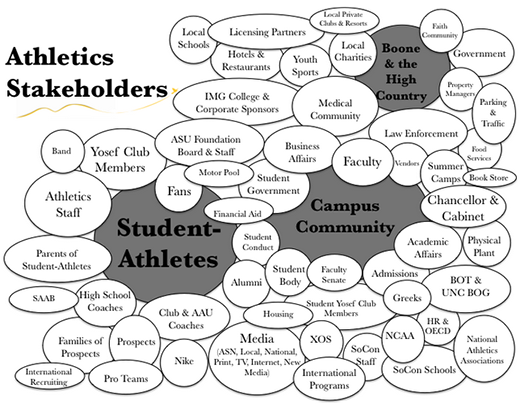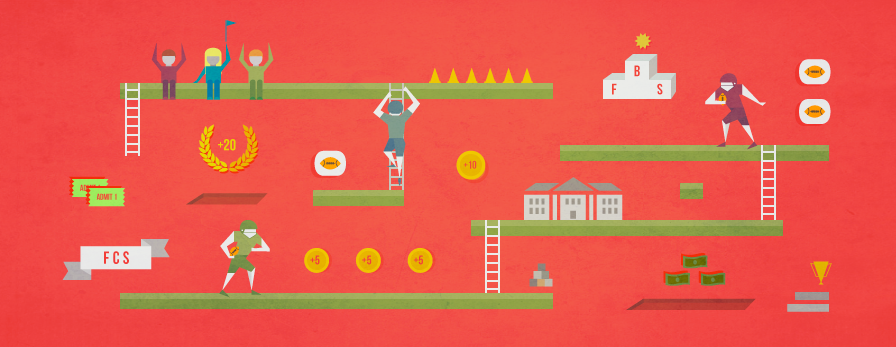In a recent article, the New York Times described challenges facing FCS programs in moving up to the FBS level. The issue is many faceted and the decision making process, within in an operational context, is complex, including satisfying numerous stakeholders. University branding, university recruitment in new markets, and additional revenue for athletics appear to be the consistent drivers for the decision to change, but we wanted to know more about how these determinations were arrived at—what qualitative and quantitative factors are relevant given the context?
Two ADs whose programs have made the jump to FBS were good enough to sit down with us to discuss the transition, Dr. Joel Erdmann of the University of South Alabama, and Charlie Cobb of Appalachian State University.
In light of this NY Times story, can you share what’s not understood (or less understood) about the decision to make a move, since the media narrative is somewhat negative generally around the costs associated with football? Help us understand the gap between the reporting and reality in your operating environment of rational actors.

Joel Erdmann – South Alabama
Director of Athletics
College football at the FBS level is expensive. The costs are substantial. At South Alabama, though, we feel the benefits far outweigh the associated costs, and therefore, moving up to FBS-level football made sense for us. Each school is in a unique situation, and from that perspective, it’s imperative to examine the individual, school-specific factors when assessing a move to FBS-level football. Additionally, there are many tangible, yet qualitative ramifications of FBS-level football which don’t appear in a simple revenue/expense breakdown because they can’t easily be valued. Therefore, a lot of reporting tends to focus around just the cost side because they are the easiest to assess and measure.

Charlie Cobb – Appalachian State
Director of Athletics
Our most important recommendation was that any FBS move would positively impact the academic mission of our University. The academic profile of incoming freshmen is one of the highest in the UNC system. Appalachian State has over 105,000 alumni, yet the average age is 32, so we are also an evolving institution in every sense of the word. Our goal through any realignment process is for athletics to continue its part in positively impacting the Appalachian Family.
When looking at our attendance, ticket sales, and fundraising support, we enjoy tremendous support from alumni, friends, and students. We also enjoy great competitive success at the FCS level. Our second biggest challenge is to continue this support and success through our efforts. Because our campus is limited in terms of student growth, we cannot and will not grow athletics through large increases in student fees or university assessments.
How long in the making was your decision to move up to FBS? Discuss what you needed to do, tactically and strategically, in order to facilitate a move up?

Joel Erdmann – South Alabama
Director of Athletics
The decision to add football goes back several years. In the late 90’s, club football at South Alabama drew quite a bit of interest, and while the idea of adding football had been around before that time, this served as a catalyst for eventually adding varsity football. Really the process of implementing varsity football began among the students, specifically the student government association. While they operated in conjunction with proper faculty and school leadership all along the way, it was the students who gathered the signatures signifying they not only wanted varsity football, but most importantly, would also be willing to support the program through annual fees. Once enough signatures were obtained, a formal initiative was presented before the Board of Trustees and in 2007-08, South Alabama made the formal announcement declaring the goal to have an FBS-level football program competing in the Sun Belt conference. In all, it was a very collaborative effort between student and school leadership, not necessarily demanding either side operate tactically or strategically, per se.

Charlie Cobb – Appalachian State
Director of Athletics
In 1998, Appalachian commenced a campus-wide study to look at playing IA football. At that time, the determination was made that the University was not ready to “move up.” After 3 FCS national championships (2005-2007), the 2007 Michigan win and the changing landscape, it became obvious that we needed to revisit that recommendation.
Initially, we looked at the four recommendations from the 1998 study that dealt with increased ticket sales and attendance, growth in the fan base, competitive success, and university support for athletics and determined that we had more than met the stated goals. We then commissioned an external study of our facilities and operating budget as compared with aspirational FBS schools. We found that we were more than comparable to most. As a result, we commissioned a study involving many stakeholders over a period of one year.
Who were the key constituents, both internally and externally, you had to consult and get ‘on-board’ during the process?

Joel Erdmann – South Alabama
Director of Athletics
The students were the constituency driving the process. Without their willingness to add football, and most importantly support it through fees, it never would have happened. And as mentioned previously, the students were working in conjunction with faculty and school leadership throughout the process, so everyone was ‘on-board’ and informed throughout. Beyond students and faculty, other key constituencies included alumni, members of the community, and all citizens of Mobile. And like students and faculty, these groups were generally excited about the prospect of South Alabama football, with a consensus feeling this was a very good thing. People recognized this process transcended simply adding football, and would unquestionably have a tremendous impact on the community going forward.

Charlie Cobb – Appalachian State
Director of Athletics
With acknowledgement to Sandy Barbour and a presentation she did several years ago at NACDA, the best way to answer this is to attach a stakeholders chart that we developed as part of our study. We held over 40 presentations with all groups during our study. Our president and Board of Trustees chair were emphatic that this would be a very public discussion for our University.

In analyzing the costs and benefits of moving up, what factors most contributed to each side of that equation? What was the process of performing your analysis like? How did you obtain the needed information?

Joel Erdmann – South Alabama
Director of Athletics
The cost-benefit analysis related to adding varsity football, and specifically FBS-level football, involves both quantitative and qualitative elements. From a numbers standpoint, we were able to examine football-specific financial data from Sun Belt and Conference USA institutions to get a firm understanding of the costs FBS-level football would entail, down to the line by line level of a budget. There was no doubt the cost was substantial—it’s an expensive sport. And the last thing we wanted to do was tip-toe through. If we were to commit, we had to make certain, through our analysis of funding sources and projected revenues/expenses, football would be sustainable. In the end, South Alabama was able to build a solid, logical plan to implement and sustain FBS-level football based on a firm financial structure not overly dependent on highly-fluid revenue streams.
Equally important as the quantitative elements, though, were (and are) the qualitative ones. Football, particularly at the collegiate level, is woven into the fabric of life in Alabama. Being in Mobile and not having college football really went against the grain culturally. Since announcing our intent to add FBS football, the current of support has been tremendous. The pride and awareness for not just USA football, but the whole school has increased greatly. Those are things which are hard to attach specific dollar amounts to. Each football game is a gathering of thousands of USA students, alumni and supporters—the most in one place, at one time, the school has ever seen.
Parallel to the implementation of the football program was the creation of the Jaguar marching band. The marching band, now two hundred and fifty strong, is the reason renowned conductors and music professors have come to South Alabama. It’s a great story of an athletic program’s growth occurring simultaneously with an academic (in this case fine arts) program. Additionally, we’ve seen a significant impact on fundraising; we’re able to make more contact with alumni and non-alumni both than ever before. Lastly, having an FBS-level football program has an effect on the students. While a football program isn’t the factor for potential students, it certainly can be a deciding factor between two like institutions where one possesses football and the other does not.

Charlie Cobb – Appalachian State
Director of Athletics
We did multiple financial analyses of projected budgets that projected growth in expenses and revenues that we felt would make us competitive at the FBS level. Only time will tell the accuracy of those projections.
How often do you re-visit initial projections and assumptions about moving up? Have you generally found these initial projections to be accurate? If not, why and what revised strategies are you developing and deploying?

Joel Erdmann – South Alabama
Director of Athletics
Admittedly, the projection and planning process occurred prior to my arrival at South Alabama, but by and large the cost projections have proved to be accurate. This goes back to the original planning performed, and most notably being able to examine the football-related costs of programs in the Sun Belt and CUSA. That’s not to say, though, there haven’t been surprises along the way—there have, particularly unforeseen costs. Our department, however, is able to manage these fluctuations, and with each passing year we gain more experience and are better able to understand how the football operating environment works.

Charlie Cobb – Appalachian State
Director of Athletics
Like most campuses, the realignment of athletics is a constant conversation. We review our data constantly and are content with the projections at this point.
To listen to NCAA experts discuss their latest research in our other podcasts, click here.




